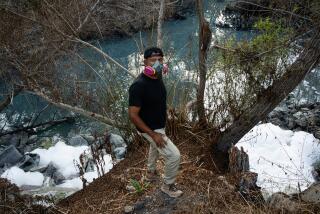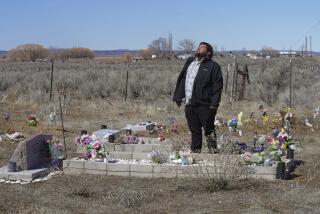The Faces of Pollution : In N.Y., Toxic Waste, Contaminated Animals Threaten Mohawk Culture’s Survival
- Share via
HOGANSBURG, N.Y. — When a snapping turtle from the St. Lawrence River was found to be so laden with PCBs that its fat could qualify as toxic waste, the Mohawk Indians regarded it as an especially significant omen.
In the mystical religion of the Mohawks, the turtle is symbolic of the very foundation of the natural world. Tribal elders pass on an ancient story of creation in which the Earth took shape on a turtle’s back.
Now, the turtle has taken on a somber new symbolism for the Mohawk Nation of the Iroquois. Its tainted flesh is a sign of the defilement of nature, of the poisoning of the bountiful river from which the Mohawks have drawn sustenance and inspiration for centuries.
Let Nets Rot
“I used to have my nets in the river,” said Tom Porter, a Bear Clan chief at the St. Regis Reservation, which the Mohawks call Akwesasne. “My family ate fish almost every day. Then they told us of mercury contamination, mirex and PCBs. I pulled my nets out and let them rot.”
To traditional Mohawks like Porter, who are trying to maintain their cultural identity by living off the land according to age-old customs, the environmental ills are more than a health threat. They are seen as a threat to the very fabric of Mohawk society.
“Our traditions survive in doing things the Mohawk way,” said Katsi Cook, a Mohawk midwife. “Our whole ceremonial life, our cosmological life, is based on nature. Without that river, we lose Akwesasne.”
Akwesasne--”Land Where the Partridge Drums”--is a 25-square-mile reservation that spans the St. Lawrence River and the international border between northern New York and Canada. It is home to about 8,000 Mohawks.
To outsiders whizzing down the state highway that cuts across it, the reservation is a brushy flatland cluttered with garish tourist traps--bingo halls, truck stops, drive-through, tax-free cigarette stands.
Less obvious to the casual observer are the fishing villages along the river, the prolific vegetable gardens, the marshes teeming with ducks, the new cultural center displaying intricately woven sweet grass baskets and beadwork wrought by Mohawk artisans.
Just beyond the western boundary of the reservation, industrial complexes sprawl along the river.
Cheap hydroelectric power and access to international shipping on the St. Lawrence Seaway made the remote rural area near Akwesasne an attractive location for aluminum smelters, foundries, chemical factories and paper mills.
A General Motors foundry abuts the western edge of Indian land, with a Superfund-listed, PCB-filled dump perched at the very brink of the river. Wild animals caught nearby have been found to be loaded with polychlorinated biphenyls (PCBs). Mohawks fear that the game that supplements the diets of many families is no longer edible.
Cattle Wiped Out
A yellow-gray haze of metallic-smelling smoke laden with fluoride drifts over Cornwall Island, the agricultural center of the reservation, from a nearby aluminum smelter. Mohawk cattle herds were virtually wiped out more than a decade ago, the animals wasting away with brittle bones and rotting teeth. A Cornell University study confirmed fluoride poisoning.
Reynolds Metals Co. cut its fluoride emissions from 300 pounds per hour in 1959 to 75 pounds per hour by 1980. Reynolds and Alcoa in nearby Massena agreed to pay $650,000 in damages two years ago, to settle a $150-million lawsuit brought by the Mohawks. But the cattle herds have not recovered.
“When I was a teen-ager, my friends and I always talked of one day having farms on Cornwall Island,” said Cook, 35, who delivers babies on the reservation but lives in Ithaca, about 220 miles southwest. “We left because of the pollution. It’s hard to build a traditional life style on a pile of toxic waste.”
Cook has become one of the leaders in the fight to clean up the pollution in the place where she was born.
“I never wanted to be an environmental activist,” Cook said. “I just wanted to deliver babies.” But she saw several infants with birth defects such as cleft palate, deafness and intestinal abnormalities, and wondered if the pollution was affecting human health.
In 1985, Cook turned to Ward Stone, a New York state wildlife pathologist whose work has been influential in spurring environmental cleanup. She asked him to investigate whether pollutants were moving through the food chain at Akwesasne.
Stone tested the flesh of a snapping turtle captured within 300 feet of the GM landfill. He found PCBs at a level of 835 parts per million (p.p.m.) in the turtle’s fat. A level above 3 p.p.m. in poultry fat is deemed unfit for human consumption.
“In soil, 50 p.p.m. on a dry weight basis is considered hazardous waste,” Stone said. “So you could say this animal would qualify as hazardous waste.”
‘Massive’ Problem
Stone continued his sampling of fish and wildlife at the reservation, working with a group of Mohawk interns. In 1985, he found a PCB level of 11,522 p.p.m. in a shrew--the highest level he had ever seen in any mammal. Last fall, he found a PCB level of 3,067 p.p.m. in the fat of another snapping turtle.
“They have a massive pollution problem,” Stone said. “We’ve pushed the Mohawk people onto a tiny postage-stamp piece of land, and now we’ve polluted it so their traditional life style is in jeopardy.”
“What happens to a people when you remove their source of protein?” said Henry Lickers, a Mohawk environmentalist who led the court battle against Reynolds. “Protein has become a very scarce commodity here, very expensive in a community where more than 70% of the people are on public assistance. Instead of cattle, fish and game, people are eating macaroni, potatoes and bread. And that’s in a population where 50% of the people over the age of 40 are confirmed diabetics.”
The eggs of a giant sturgeon caught in 1986 had PCB readings at 8 p.p.m., four times the permissible level. That raised concern over the future of a lucrative Mohawk industry: the sale of caviar, which goes for $30 an ounce in luxury markets in New York City and Montreal.
Francis Jock, a 45-year-old Mohawk fisherman who lives in a white clapboard cottage on the river bank, caught the toxic sturgeon as well as other fish sampled by Stone. He said the pollution has hurt not only the commercial fishing industry, but also the tourist trade.
“We used to have a lot of fishing camps here,” Jock said. Anglers from across the Northeast would hire Mohawk guides, whose skills on the river are legendary. “Now they can’t eat the fish, so they don’t come.”
Jock worries about the spiritual as well as financial loss. “When you’re out on the river, you can think, you’re at peace with yourself,” he said. “You can talk with your maker. The young people aren’t learning that now.”
Lunch of Muskrat
Tony Barnes, a 67-year-old Mohawk hunter, trapper and purveyor of herbal medicines, provides Stone with the carcasses of ducks, muskrats, beavers, salmon and other creatures for testing.
Over a lunch of muskrat, partridge, rabbit and homemade pickles on a recent afternoon, Barnes talked about his days as a guide.
“People came from all over to fish for muskie. I caught more than any other guide,” Barnes said, hauling out a scrapbook filled with yellowed newspaper photos of grinning men with strings of fish. “We closed the fishing camp three years ago because of the pollution.”
“We used to have perch for breakfast every day,” added Barnes, who has nine children and 14 grandchildren. “Now we don’t eat fish more than once a week. We eat birds and rabbits, squirrels. This is the first muskrat we’ve eaten in three years. I’ve caught 112 for the tests.”
Stone’s studies are intended to track the movement of toxic chemicals through the environment, with exhaustive analyses of soil, river sediments, plants, leeches, insects, fish, birds and a broad range of animals. Some of the data will be used by state health officials to assess the risk of eating various species of fish and game.
Fluoride Poisoning
It is one of many pollution studies coordinated by Mohawk health officials. In the early 1970s, Cornell University veterinarians documented fluoride poisoning of Mohawk cattle. About the same time, a University of Montana scientist found high fluoride levels in plant samples from Cornwall Island.
In 1981, scientists from the Mt. Sinai School of Medicine studied fluoride in the Mohawk people but found no persuasive link to clinical illness.
“Up until 1983, GM denied there was a PCB problem,” said Jim Ransom, an environmental technician with the St. Regis Tribal Council. The Environmental Protection Agency fined the company $507,000 that year for illegal use, storage and disposal of PCBs.
A $1.2-million remediation study started by GM in 1985 under federal orders showed 23,000 cubic yards of PCB-contaminated sediments in the river adjacent to the plant, Ransom said.
The study also showed PCB contamination of drinking water wells on Raquette Point, just downstream from the GM plant. The company supplied bottled water to those affected--including the Freedom School, an elementary school where Mohawk children are taught in their native language.
sh PCBs in Breast Milk
Cook is now working on a study of PCBs in the breast milk of Mohawk women. Cornell scientists are involved in several projects at the reservation, including a study of human health risks, contamination of the food supply and effects on the immune systems of dogs.
“It was a very long fight to bring recognition to these problems,” said Lickers, who has been fighting the polluters for 12 years as director of the Environmental Division of the Mohawk Band Council.
Dealing with the environmental ills, Lickers said, has been complicated by the complex political situation at the reservation, which overlaps the jurisdictions of environmental agencies in the United States, Canada, New York state and the provinces of Quebec and Ontario.
And there are three Indian governments: the Canadian-backed Mohawk Band Council, the U.S.-backed St. Regis Tribal Council and the traditionalist Mohawk Nation Council of Iroquois Confederacy chiefs.
Although various Mohawk factions have clashed over issues like bingo and slot machines, an overriding concern for the environment has fostered close cooperation on pollution studies--even during an armed standoff between traditionalist and tribal factions in 1979, Lickers said.
Stone is skeptical that Akwesasne will ever be clean enough to supply safe fish and game to its people. “I don’t think you’ll ever be able to clean up a mess like this, although you can reduce it,” he said.
New Life
Porter talks of leaving, of starting a new life with other traditional families.
“If we could find 5,000, maybe 20,000 acres of land, with no factories polluting it, we could go and start over, live the way we’re supposed to live,” he said.
But Lickers is steadfast in his belief that the river will one day be clean enough for his grandchildren to swim in.
“What keeps me going is believing that river will be clean,” he said. “We aren’t looking for a big monetary settlement. We just want the tools to restore the environment. To develop marsh management plans. To put bass boxes in the river. To improve the pickerel spawning beds. To study protein sources like flint corn, a traditional Indian corn that’s high in protein and low in starch.
“In Love Canal, the people got compensation and moved away,” Lickers said. “But we have no place to run. Our people have been here for 10,000 years. This is our homeland.”
More to Read
Sign up for Essential California
The most important California stories and recommendations in your inbox every morning.
You may occasionally receive promotional content from the Los Angeles Times.










